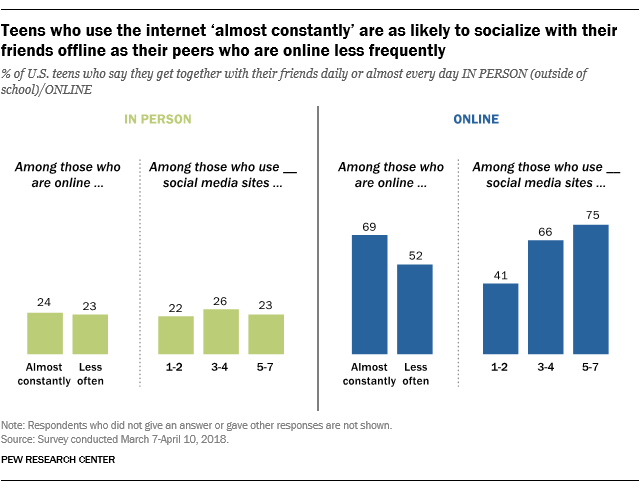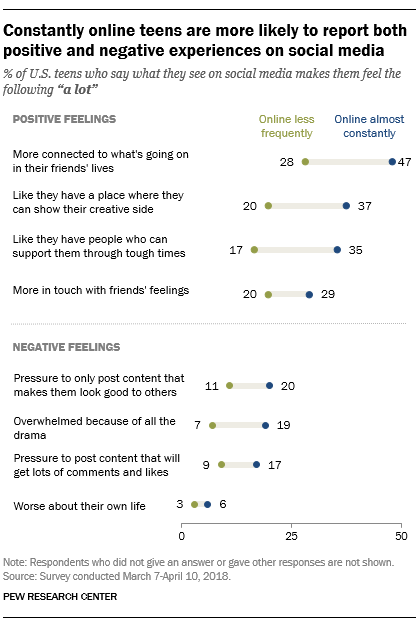Close to half of U.S. teens ages 13 to 17 say they are on the internet “almost constantly,” and more than nine-in-ten are social media users. These highly plugged-in youth, however, are just as likely as their less-connected peers to socialize regularly with their friends in person, according to a new analysis of Pew Research Center survey data.
 In fact, when taking into account both online and offline interactions, highly connected teens report more contact with their friends compared with other teens, according to the analysis, which comes amid concerns that screen time is taking away opportunities for teens and others to socialize face-to-face.
In fact, when taking into account both online and offline interactions, highly connected teens report more contact with their friends compared with other teens, according to the analysis, which comes amid concerns that screen time is taking away opportunities for teens and others to socialize face-to-face.
Overall, 24% of teens who report being constantly online say they meet with their friends in person outside of school every day or almost every day. That is nearly identical to the 23% of less-frequently online teens who say they see their friends almost daily. And when it comes to online interaction with their friends, 69% of teens who are online constantly say they talk to their friends online every day or almost every day, compared with 52% of teens who visit the internet less frequently.
The survey also finds that teens who use five or more social media sites are significantly more likely than teens who use fewer sites to talk to their friends online every day or almost every day. Three-quarters of these social media users (75%) say this, compared with 41% of teens who use just one or two social media platforms. However, the frequency with which teens meet their friends in person does not significantly differ by the number of social media sites they use. Some 22% of teens who use one or two online platforms meet their friends in person on a near daily basis, compared with 26% of teens who use three or four social media sites and 23% of teens who use five or more sites.
It’s worth noting that regardless of how frequently they use the internet or how many social media sites they use, teens today are far more likely to maintain frequent contact with their close friends online than in person.
Additionally, the likelihood of teens having a close friend does not differ by their frequency of internet use. The vast majority of teens in each group say they have at least one close friend. And similar shares of teens who are constantly online (53%) and who are online less frequently (49%) say they tend to fit in pretty easily with other people their age.
 When it comes to their broader attitudes toward technology, teens who go online almost constantly see a wider range of positive effects from social media than their peers who use the internet less frequently. For instance, they are substantially more likely to say that social media makes them feel a lot more connected to what’s going on in their friends’ lives and that they have people who can support them when going through tough times.
When it comes to their broader attitudes toward technology, teens who go online almost constantly see a wider range of positive effects from social media than their peers who use the internet less frequently. For instance, they are substantially more likely to say that social media makes them feel a lot more connected to what’s going on in their friends’ lives and that they have people who can support them when going through tough times.
At the same time, this heightened connectivity can come at a cost for some teens. Constantly online teens are around twice as likely as other teens to report that they feel a lot of pressure to only post content on social media that makes them look good to others, or to post content that will gain comments and likes. And teens who are online on a near-constant basis are also more likely to report having experienced online harassment and cyberbullying than teens who are online less frequently.
Previous Pew Research Center surveys have similarly found that the use of internet and social media is linked to stronger social ties, both among teens and adults. A 2014 Center survey of teens ages 13 to 17 found that those who had access to a smartphone or used social media were more likely than non-users of those technologies to keep in touch daily with their close friends. And a survey of U.S. adults in 2004 found that adult internet users had larger social circles than non-internet users. A separate 2010 study found that Facebook users were more likely than non-users to have close interpersonal relationships and receive support from others.


